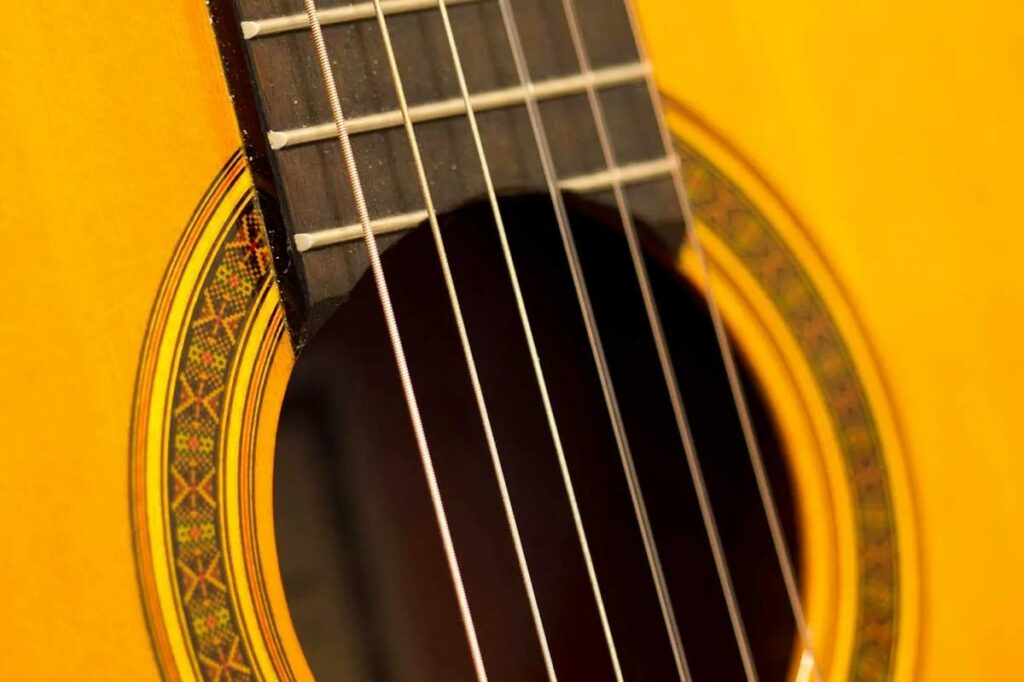Changing strings is the easiest and least expensive way to meaningfully alter the character of a guitar, and it’s definitely worth spending some time and a few dollars to investigate the various options and find the best fit for each specific guitar, as what works for one may not be ideal for another.
Q: Can you give an analysis of nylon strings and when to change them? Also, I would welcome a discussion on the various metals used in today’s string making. Santa Cruz’s Parabolic Tension sets are sold by tension vs. gauge, for instance.
—Iven
A: Thanks for the question. Strings are a perennial topic with my clients, and a much deeper one than many people realize.
Nylon strings typically stay on guitars much longer than steel, for a few reasons. First of all, the plain nylon treble strings are not subject to the rust and corrosion issues that cause steel-string players to reach for a fresh pack. Outside the classical world, nylon-string guitars are also typically favored for their warmer, mellower sound, so players don’t usually mind if the strings aren’t delivering the bright and brilliant trebles that come with a brand-new set. Beyond this, nylon strings take a much longer time to stretch and settle in, resulting in a guitar that will need frequent retuning for days after a string change, so many of my clients prefer to live with the old strings that have finally stabilized.
The wound bass strings are the main reasons why I end up changing nylon strings—the silver-plated copper windings on these strings are both thin and soft, so the frets can wear through them, causing dimples and, eventually, broken windings in the string. Strings can still work adequately for a while after these dimples have started, but nonetheless they spell the beginning of the end.
Mainly because of the stretching issues with pure nylon, companies have experimented with different compositions of treble strings. The most notable are the carbon or fluorocarbon composition strings, which purport to offer a longer-lasting brightness along with reduced stretching and greater pitch stability. As with guitars (and just about everything else), tastes and opinions vary on the performance of these modern alternatives, so, once again, I encourage players to experiment with pairing each guitar with its best-fit set of strings.
Finally, since pitch instability is a frequent deterrent for my clients who might otherwise install new strings, I encourage sometime nylon-string players to spend a few moments learning how to properly tie the strings at the bridge, and correctly wind them on the tuning posts. This can make a world of difference in reducing the settling-in time. Slack that is trapped in the loops or knots will slowly work back into the main string length and can make accurate tuning very challenging.
A conversation about the various alloys in steel-string windings would probably need a whole article, but I’d like to touch on a quick but important consideration—your point about tension versus gauge. This is an often-misunderstood set of variables. The string’s gauge, which is simply the diameter measured in thousandths of an inch (.052 inches, or 52 thousandths, for example) is the most common metric used to select strings and is generally the most useful. However, two equally gauged strings can have different tensions, the result of differing ratios between the core and wrap wire diameters. As an example, consider two core wires of equal diameter. We can add wrap wire to one, increasing its mass and slowing down its vibration, which will lower the pitch. However, the tensions will stay the same, since the core wire is what carries the load.
In contrast, we could theoretically take two different-sized core wires and apply different wraps to them to achieve the same final pitch. In this case, the tensions would be different, even though the target note is the same.
Although the majority of steel strings use core/wrap ratios that are fairly similar, there are nonetheless differences that can be felt by the sensitive player. In some cases, these differences are sufficient that I need to make a truss rod adjustment when switching from one brand of .012–.052 strings to a different brand of the same gauge. This is also why some players instinctively prefer one brand over another, even if the gauges are apparently the same. The density of the wrap wire (80/20 bronze vs. phosphor vs. steel, etc.) will also affect these nuances of feel and tension.
Thankfully, strings are relatively inexpensive and easy to change, so there is little to be lost by experimenting—and finding the right match between string and guitar can have a very rewarding result.
This article originally appeared in the July/August 2024 issue of Acoustic Guitar magazine.
>>> Read full article>>>
Copyright for syndicated content belongs to the linked Source : AcousticGuitar – https://acousticguitar.com/all-about-nylon-strings-and-modern-steel-sets/
